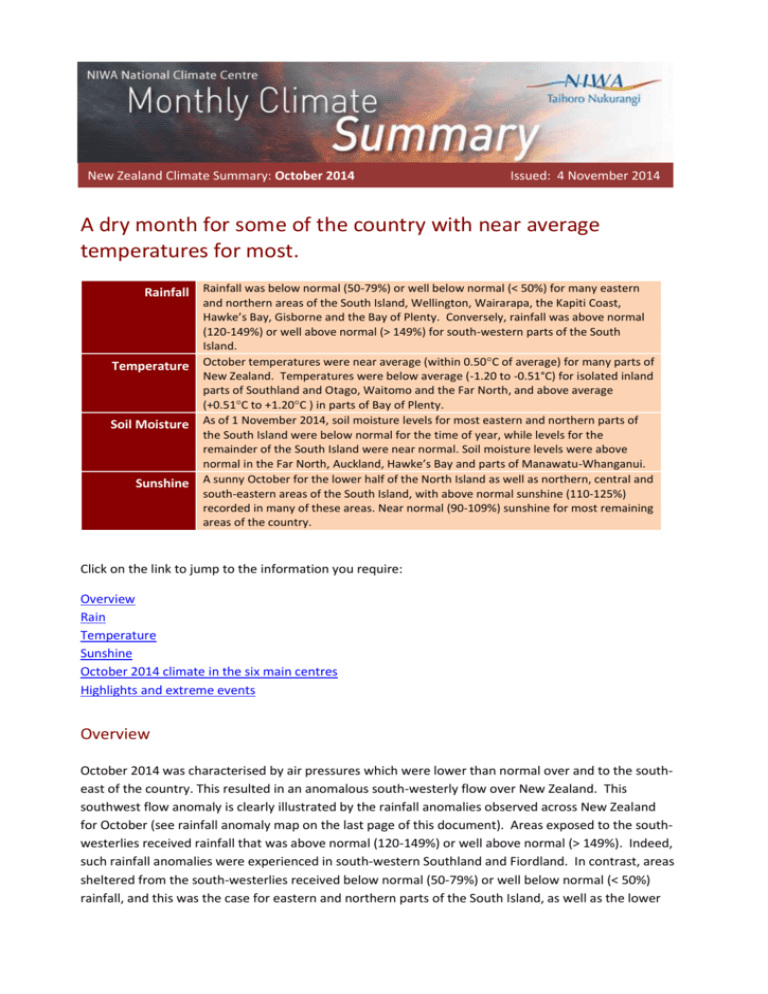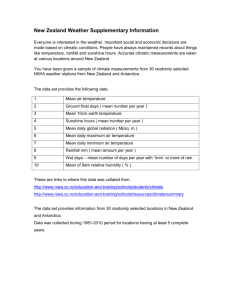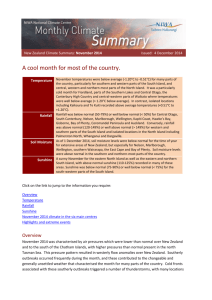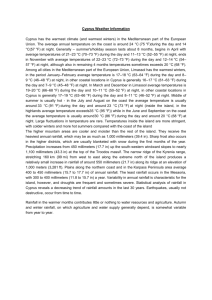
New Zealand Climate Summary: October 2014
Issued: 4 November 2014
A dry month for some of the country with near average
temperatures for most.
Rainfall Rainfall was below normal (50-79%) or well below normal (< 50%) for many eastern
Temperature
Soil Moisture
Sunshine
and northern areas of the South Island, Wellington, Wairarapa, the Kapiti Coast,
Hawke’s Bay, Gisborne and the Bay of Plenty. Conversely, rainfall was above normal
(120-149%) or well above normal (> 149%) for south-western parts of the South
Island.
October temperatures were near average (within 0.50°C of average) for many parts of
New Zealand. Temperatures were below average (-1.20 to -0.51°C) for isolated inland
parts of Southland and Otago, Waitomo and the Far North, and above average
(+0.51°C to +1.20°C ) in parts of Bay of Plenty.
As of 1 November 2014, soil moisture levels for most eastern and northern parts of
the South Island were below normal for the time of year, while levels for the
remainder of the South Island were near normal. Soil moisture levels were above
normal in the Far North, Auckland, Hawke’s Bay and parts of Manawatu-Whanganui.
A sunny October for the lower half of the North Island as well as northern, central and
south-eastern areas of the South Island, with above normal sunshine (110-125%)
recorded in many of these areas. Near normal (90-109%) sunshine for most remaining
areas of the country.
Click on the link to jump to the information you require:
Overview
Rain
Temperature
Sunshine
October 2014 climate in the six main centres
Highlights and extreme events
Overview
October 2014 was characterised by air pressures which were lower than normal over and to the southeast of the country. This resulted in an anomalous south-westerly flow over New Zealand. This
southwest flow anomaly is clearly illustrated by the rainfall anomalies observed across New Zealand
for October (see rainfall anomaly map on the last page of this document). Areas exposed to the southwesterlies received rainfall that was above normal (120-149%) or well above normal (> 149%). Indeed,
such rainfall anomalies were experienced in south-western Southland and Fiordland. In contrast, areas
sheltered from the south-westerlies received below normal (50-79%) or well below normal (< 50%)
rainfall, and this was the case for eastern and northern parts of the South Island, as well as the lower
North Island, Hawke’s Bay, Gisborne and the Bay of Plenty. Remaining areas of the country typically
received near normal rainfall (within 20% of normal) for the month.
Soil moisture levels on the east coast of the South Island were below normal for the time of year at the
start of the month, and this remained the case as of 1 November 2014 after a relatively dry October
there. Likewise, at 1 November 2014 soils were drier than normal for the time of year in Marlborough
and Nelson. Soils were wetter than normal in the Far North, Auckland, and parts of ManawatuWhanganui. Soils were also wetter than normal in Hawke’s Bay despite the region receiving below
normal rainfall in October: soil moisture levels have remained relatively high as a result of above
normal September rainfall that was received in the region. Soil moisture levels were near normal for
the time of year for remaining areas of New Zealand.
October saw near average temperatures (within 0.50°C of average) for most areas of the country
overall. However, there was considerable day-to-day variability of temperatures at times as the
anomalous south-westerly flow for the month overall (as outlined earlier) shifted between more
westerly and southerly variations. Temperatures were much cooler than average during the early part
of October, with a cool southerly flow bringing snow to low elevations in both the North and South
Islands. The latter half of the month saw warmer than average temperatures across most of New
Zealand. This effectively offset the cold start to the month, meaning temperatures were near average
across most of New Zealand for the month as a whole. However, October was a cool month for
isolated inland parts of Southland and Otago, Waitomo and the Far North, where temperatures were
below average (-1.20 to -0.51°C), while above average temperatures (+0.51°C to +1.20°C) were
observed in isolated inland parts of Bay of Plenty. The nation-wide average temperature in October
2014 was 12.2°C (0.1°C above the 1971-2000 October average from NIWA’s seven station temperature
series which begins in 1909)1.
October was a sunny month for the lower half of the North Island as well as northern, central and
south-eastern areas of the South Island, with above normal sunshine (110-125%) recorded in many of
these areas. Balclutha, Dunedin, Cheviot and Martinborough enjoyed near-record high sunshine hours
for the month. Sunshine hours were near normal (90-109%) for most remaining areas of the country.
Further Highlights:
1
The highest temperature was 27.5°C, observed at Christchurch (Riccarton) on 17 October.
The lowest temperature was -4.9°C, observed at Middlemarch on 25 October.
The highest 1-day rainfall was 204 mm, recorded at Milford Sound on 5 October.
The highest wind gust was 196 km/hr, observed at Cape Turnagain on 6 October.
Of the six main centres in October 2014, Auckland was the warmest, Dunedin was the coolest,
Christchurch was the driest, Hamilton was the wettest and cloudiest and Wellington was the
sunniest.
Interim value
Of the available, regularly reporting sunshine observation sites, the sunniest four centres2 so
far in 2014 (1 January to 31 October) are: Whakatane (2216 hours), Lake Tekapo (2020 hours),
Nelson (2005 hours) and Blenheim (1997 hours).
For further information, please contact:
Mr Chris Brandolino
NIWA Forecaster – NIWA National Climate Centre
Tel. 09 375 6335, Mobile (027) 886 0014
Rainfall: Dry for areas sheltered from south-westerlies
October was a dry month for areas of the country sheltered from south-westerly winds. It was
especially dry in Nelson and Blenheim, with these locations receiving just 26% and 32% of normal
October rainfall respectively. Parts of the Kapiti Coast, Wellington, Christchurch and Central Otago
were similarly dry and received less than 50% of normal October rainfall. The Southern Alps of the
South Island are a significant barrier to the westerly progression of weather systems typical in the New
Zealand region. As a result, a rain-shadow is established whereby rainfall totals (at all time-scales)
typically decline considerably as you move east of the mountain range. The rain-shadow effect of the
Southern Alps was clearly demonstrated this month, with Mount Cook Village recording 411 mm of
rainfall, whereas Lake Tekapo (~30 km south-east of Mount Cook Village) recorded just 42 mm of
rainfall. Despite the lack of rainfall observed in many parts of the country, only one location (Motu,
see table below) recorded a near-record low rainfall total for the month. Rainfall was above normal
for the south-west of the South Island, however no locations observed record or near-record high
rainfall totals for the month.
Record3 or near-record October rainfall totals were recorded at:
Location
Rainfall
total (mm)
Low records or near-records
Motu
2
102
Percentage
of normal
Year
records
began
Comments
49
1990
2nd-lowest
New Plymouth sunshine is still omitted from this ranking while recent instrumentation changes are assessed.
The rankings (1st, 2nd, 3rd.etc) in all Tables in this summary are relative to climate data from a group of nearby
stations, some of which may no longer be operating. The current climate value is compared against all values
from any member of the group, without any regard for homogeneity between one station’s record, and another.
This approach is used due to the practical limitations of performing homogeneity checks in real-time.
3
Temperature: Near average for most of New Zealand
Temperatures for the month as a whole were near average across the majority of New Zealand. This is
reflected in the following three tables, which show relatively few locations observing record or nearrecord mean, mean maximum or mean minimum temperatures. Perhaps most notable this month was
Wallaceville (Upper Hutt), which observed both its highest mean maximum air temperature on record
and its second-lowest mean minimum air temperature on record. This suggests that the area observed
relatively clear skies during the month, with a lack of cloud allowing for warm sunny days and cool
clear nights. This suggestion is supported when observing the sunshine anomalies of nearby locations:
Wellington observed 115% of normal October sunshine hours and Martinborough observed 122% of
normal sunshine hours. The nation-wide average temperature in October 2014 was 12.2°C (0.1°C
above the 1971-2000 October average from NIWA’s seven station temperature series which begins in
1909).
Record or near-record mean air temperatures for October were recorded at:
Location
High records or near-records
Te Puke
Low records or near-records
Kaitaia
Mean
air temp. (oC)
Departure from
normal (oC)
Year records
began
Comments
14.5
1.2
1973
3rd-highest
13.2
-1.2
1967
3rd-lowest
Record or near-record mean maximum air temperatures for October were recorded at:
Location
Mean maximum
air temp. (oC)
High records or near-records
Wallaceville
Low records or near-records
Secretary Island
Kaitaia
Departure from
normal (oC)
Year records
began
Comments
18.3
2.4
1939
Highest
12.8
16.8
-1.0
-1.2
1985
1967
2nd-lowest
3rd-lowest
Record or near-record mean minimum air temperatures for October were recorded at:
Location
High records or near-records
Te Puke
Low records or near-records
Wallaceville
Cheviot
Lumsden
Tiwai Point
Hanmer Forest
Timaru
Mean minimum
air temp. (oC)
Departure from
normal (oC)
Year records
began
Comments
10.1
1.7
1973
4th-highest
4.9
4.5
3.3
5.9
1.3
3.1
-2.7
-1.0
-1.2
-1.0
-2.3
-1.6
1939
1982
1982
1970
1906
1885
2nd-lowest
3rd-lowest
3rd-lowest
3rd-lowest
4th-lowest
4th-lowest
Sunshine: Normal or above normal across the country
October was a sunny month for the lower half of the North Island as well as northern, central and
south-eastern parts of the South Island. Four locations observed near-record high total sunshine hours
for the month. Cheviot observed its third-highest total sunshine hours for October on record. The
relatively clear skies observed here are likely to have contributed to cool overnight temperatures:
Cheviot also observed its third-lowest mean minimum temperature for October on record. Remaining
areas of the country were not quite as bright, and received near normal (90-109%) total sunshine
hours. Of the available, regularly reporting sunshine observation sites, the sunniest four centres so far
in 2014 (1 January to 31 October) are: Whakatane (2216 hours), Lake Tekapo (2020 hours), Nelson
(2005 hours) and Blenheim (1997 hours).
Record or near-record October sunshine hours were recorded at:
Location
High records or near-records
Martinborough
Cheviot
Dunedin (Musselburgh)
Balclutha
Sunshine
hours
Percentage
of normal
Year records
began
Comments
236
242
208
219
122
131
124
129
1986
1983
1980
1964
2nd-highest
3rd-highest
3rd-highest
3rd-highest
October climate in the six main centres
October temperatures were above average in Auckland and Wellington but near average for the
remaining four main centres. It was a relatively dry month in all main centres, but especially in
Tauranga, Wellington and Christchurch which all received less than half of their respective normal
rainfall. Wellington and Dunedin enjoyed a sunnier than normal month, whereas the remaining main
centres observed near normal total sunshine hours. Of the six main centres in October 2014, Auckland
was the warmest, Dunedin was the coolest, Christchurch was the driest, Hamilton was the wettest and
cloudiest and Wellington was the sunniest.
October 2014 main centre climate statistics:
Temperature
Mean temp. (oC)
Departure from
normal (oC)
Aucklanda
15.0
+0.6
Above average
b
14.4
+0.3
Near average
Hamiltonc
12.9
-0.1
Near average
12.6
+0.6
Above average
11.1
-0.3
Near average
10.5
-0.4
Near average
Location
Rainfall (mm)
% of normal
Aucklanda
69
76%
Below normal
Taurangab
38
42%
Well below normal
c
79
80%
Near normal
Wellingtond
514
44%
Well below normal
Christchurche
21
42%
Well below normal
46
75%
Below normal
Location
Tauranga
Wellingtond
Christchurch
e
Dunedinf
Comments
Rainfall
Hamilton
Dunedin
f
Comments
Sunshine
Location
Sunshine (hours)
% of normal
a
184
104%
Near normal
Taurangab
192
90%
Near normal
Hamiltong
163
92%
Near normal
Wellingtond
2205
115%
Above normal
Christchurche
2035
108%
Near normal
124%
Above normal
Auckland
Dunedinf
208
a
Mangere
4
Missing two days of data.
Missing one day of data.
5
b
Tauranga Airport
c
Hamilton Airport
d
Kelburn
e
Comments
Christchurch Airport
f
Musselburgh g Ruakura
Highlights and extreme events
Wind
On 2 October strong winds bore down on much of the country and flipped a trailer being towed across
the Rimutaka Hill Road (SH 2).
On 6 October strong winds hit parts of Wellington, cancelling several East by West commuter ferry
services. The Fire Service responded to dozens of callouts, including a roof lifting in Miramar and in
Upper Hutt. Strong wind gusts knocked trees and vegetation on to power lines, cutting electricity to
about 2100 homes in the capital's northern suburbs and areas further north. A fallen tree also
knocked out Tranz Metro's overhead electrical lines near Taita, cancelling some services on the Hutt
Valley and Melling rail lines and delaying services to Wairarapa during the evening rush hour. Farther
north, a tree came down on to a house and caravan in Kawerau, and many roofs were lifted off on the
east coast from Whangamata to Papamoa. A strong gust blew a truck into a ditch across the NapierHastings expressway. In Tauranga, strong winds and rough seas caused boats to break free of their
moorings. Power was knocked out in the Auckland suburbs of Green Bay, Riverhead and Titirangi due
to the high winds.
On 8 October strong winds in the Mackenzie Country knocked down six power lines, causing a loss of
power to twelve homes between Twizel and Omarama.
On 29 October strong winds across Canterbury caused power outages to more than 1700 households
in Coalgate, Darfield, Greendale and Homebush.
The highest wind gust was 196 km/hr, observed at Cape Turnagain on 6 October.
Record or near-record October extreme wind gusts were recorded at:
Location
Auckland (Whenuapai)
Rotorua
Paraparaumu
Palmerston North
Wanganui
Farewell Spit
Kaikohe
New Plymouth
Tauranga
Auckland (Mangere)
Pukekohe
Hamilton
Napier
Westport
Kaikoura
Taupo
Levin
Extreme
wind gust
(km/hr)
Date of
extreme
gust
Year
records
began
109
104
130
102
109
115
102
106
106
107
80
85
107
98
150
91
91
29th
6th
6th
6th
6th
3rd
7th
29th
6th
29th
29th
6th
6th
6th
6th
29th
6th
1972
1972
1972
1991
1977
1973
1986
1972
1973
1971
1986
1978
1973
1973
1972
1982
1971
Comments
Highest
Highest
Highest
Highest
Highest
Highest
Equal highest
Equal highest
2nd-highest
2nd-highest
2nd-highest
2nd-highest
2nd-highest
2nd-highest
3rd-highest
Equal 3rd-highest
Equal 3rd-highest
Gisborne
95
6th
1972
4th-highest
Rain and slips
The highest 1-day rainfall was 204 mm, recorded at Milford Sound on 5 October.
Record or near-record October extreme 1-day rainfall totals were recorded at:
Location
Campbell Island
Extreme 1-day
rainfall
(mm)
Date of extreme
rainfall
Year records
began
22
7th
1991
Comments
Equal 4th-highest
Temperatures
On 13 October north-westerly winds contributed to warm temperatures for the time of year
throughout the lower South Island. Maximum temperatures (and departure from average October
daily maximum temperature) observed included: Invercargill 23.0°C (+8.7°C), Manapouri 21.0°C
(+6.1°C), Lumsden 22.5°C (+7.3°C), Queenstown 22.0°C (+6.7°C), Dunedin Airport 26.0°C (+9.8°C) and
Wanaka 22.2°C (+5.9°C).
The highest daily maximum temperature was 27.5°C, observed at Christchurch (Riccarton) on 17
October. Blenheim was a close second-place, recording 27.4°C on 14 October. Timaru recorded the
third-highest daily maximum temperature for the month, with 27.2°C observed on 17 October.
The lowest daily minimum temperature was -4.9°C, observed at Middlemarch on 25 October.
Record or near-record daily maximum air temperatures for October were recorded at:
Location
High records or near-records
Kaikohe
Tiwai Point
Masterton
Nelson
Ranfurly
Whitianga
Motu
Low records or near-records
Kerikeri
Cape Reinga
Balclutha
Te Kuiti
Westport
Greymouth
Extreme
maximum (°C)
Date of
extreme
temperature
Year
records
began
Comments
22.9
23.1
25.8
24.6
24.1
23.4
23.4
15th
13th
16th
14th
13th
15th
15th
1973
1970
1992
1943
1975
1962
1990
Highest
Highest
2nd-highest
3rd-highest
3rd-highest
Equal 3rd-highest
Equal 3rd-highest
12.5
12.9
7.3
10.9
11.0
9.6
10th
10th
3rd
4th
3rd
3rd
1981
1971
1972
1959
1966
1972
Lowest
2nd-lowest
2nd-lowest
Equal 2nd-lowest
3rd-lowest
3rd-lowest
Campbell Island
Kaitaia
Paeroa
Hicks Bay
Secretary Island
4.2
12.6
12.4
12.0
8.9
27th
10th
4th
11th
3rd
1991
1971
1971
1972
1989
3rd-lowest
4th-lowest
4th-lowest
4th-lowest
Equal 4th-lowest
Record or near-record daily minimum air temperatures for October were recorded at:
Location
High records or near-records
Kerikeri
Orari Estate
Warkworth
Te Puke
Campbell Island
Whangaparaoa
Low records or near-records
Whangaparaoa
Wallaceville
Te Kuiti
Martinborough
Puysegur Point
Timaru
Haast
Cheviot
Kaitaia
Kerikeri
Extreme
minimum (°C)
Date of
extreme
temperature
Year
records
began
Comments
17.1
16.0
16.1
15.2
9.3
15.0
29th
23rd
29th
29th
2nd
29th
1981
1972
1966
1973
1991
1982
Highest
2nd-highest
Equal 3rd-highest
Equal 3rd-highest
Equal 3rd-highest
Equal 4th-highest
0.9
-3.2
-1.0
-1.2
2.8
-3.3
-0.4
-2.2
4.7
3.2
7th
5th
25th
5th
4th
4th
4th
5th
8th
8th
1982
1939
1959
1986
1978
1885
1949
1982
1985
1981
Lowest
Lowest
2nd-lowest
2nd-lowest
Equal 2nd-lowest
3rd-lowest
Equal 3rd-lowest
4th-lowest
Equal 4th-lowest
Equal 4th-lowest
Lightning and Hail
On 4 October a southerly change brought hail to areas of Wellington in the afternoon including Lower
Hutt and the Ngauranga Gorge.
On 6 October a bolt of lightning killed two calves in Featherston. The lightning melted the fence line
and carved a two metre trench in the soil.
In the early hours of 29 October, thunderstorms struck across Northland and Auckland. Approximately
16,000 lightning strikes were recorded, including one which struck an Air New Zealand flight travelling
from Auckland to New Plymouth. The areas of Kaikohe, Kaeo, Omapere and Waipapa were
temporarily without power due to faults caused by lightning strikes.
In the late hours of 29 October and early hours of 30 October the Auckland region was hit by a number
of thunderstorms. Large hail stones were reported in Auckland, whilst 600 lightning strikes were
recorded from Auckland to Taranaki. One home in East Tamaki was struck by lightning, resulting in a
2-metre wide hole in the roof.
Snow and ice
On 3 October snow fell to low elevations across the North and South Islands. State Highway 94 was
closed from lower Hollyford to The Chasm as a result of snow.
On 4 October a southerly change brought snow to the Rimutaka Hill road north of Wellington.
On 6 October snow fell to approximately 150 metres above sea level in Southland, and settled down to
elevations of 300 metres above sea level. The snowfall resulted in lamb losses and the cancellation of
two stages of the Junior Tour of Southland cycling event.
On 7 October snow overnight closed Desert Road, with the road reopened just after 8 a.m.
Cloud and fog
On 13 October heavy fog was reported in northern parts of Christchurch, prompting a warning for
motorists in those areas to exercise caution. Flights at Christchurch Airport were not affected by fog.
For further information, please contact:
Mr Chris Brandolino
NIWA Forecaster – NIWA National Climate Centre
Tel. 09 375 6335, Mobile (027) 886 0014
For climate data enquiries, please contact:
Mr Gregor Macara
Climate Scientist, NIWA Wellington
Tel. 04 386 0509
October 2014 total rainfall,
expressed as a percentage of the
1981-2010 normal.
Rainfall was below normal (5079%) or well below normal (< 50%)
for many eastern and northern
parts of the South Island, as well
as in Wellington, Wairarapa, the
Kapiti Coast, Hawke’s Bay,
Gisborne and the Bay of Plenty.
Conversely, rainfall was at least
above normal (120-149%) for the
south-west of the South Island
(blue colours on the map).
http://www.niwa.co.nz/climate © Copyright NIWA 2014.
All rights reserved.










